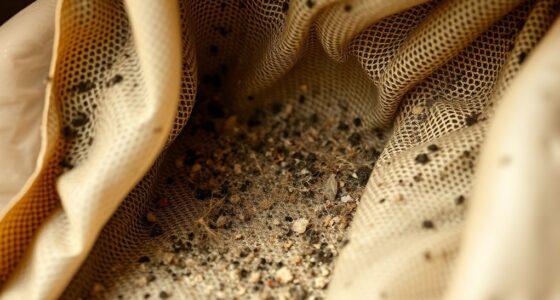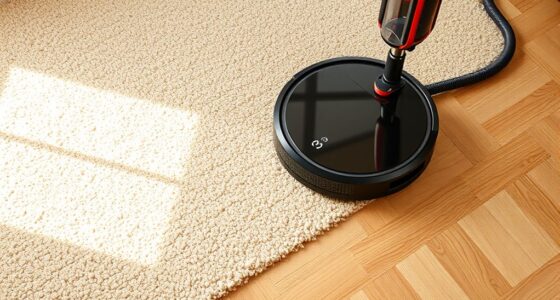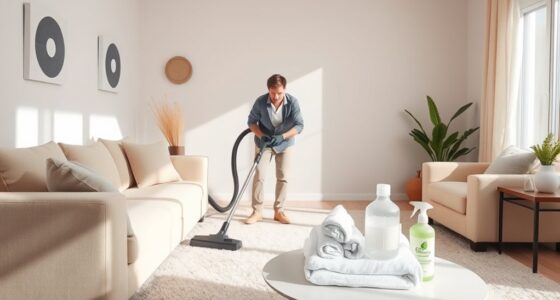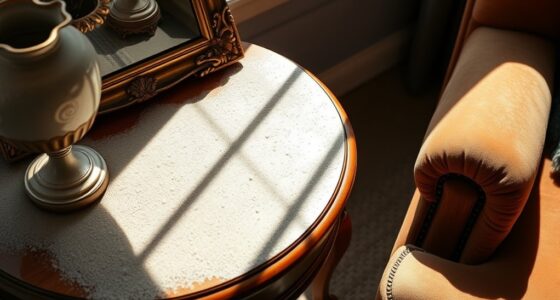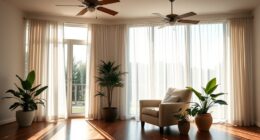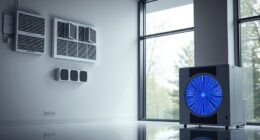To reduce airborne pollutants, dust and vacuum your surfaces regularly. Use microfiber cloths or electrostatic dusters to trap dust effectively, and focus on high-touch areas like doorknobs and electronic devices. Vacuum with a HEPA filter, moving slowly over carpets and upholstery to dislodge embedded allergens. Maintaining a consistent cleaning routine helps keep debris from settling and improves your air purifier’s performance. Keep going to discover more tips for creating a healthier indoor environment.
Key Takeaways
- Regular dusting with microfiber cloths traps dust and prevents it from becoming airborne.
- Vacuum carpets and upholstery with HEPA filters to remove embedded allergens effectively.
- Dust from higher surfaces first, then lower areas, to prevent spreading settled debris.
- Focus on cleaning high-touch surfaces like doorknobs and switches to reduce allergen transfer.
- Consistent cleaning reduces debris buildup, enhancing air purifier performance and indoor air quality.

Cleaning surfaces plays a essential role in reducing airborne pollutants that can harm your health. Dust, pet dander, and allergens settle on surfaces and can become airborne when disturbed, contributing to poor indoor air quality. To maximize the benefits of your efforts, you need to understand how effective your cleaning methods are, especially regarding air purifier effectiveness. Regular cleaning can markedly improve how well your air purifier works by lowering the amount of debris it has to filter out. It’s necessary to establish cleaning frequency tips that keep surface dust and allergens at bay without becoming overwhelming. Typically, dusting and vacuuming at least once a week is a good starting point, but high-traffic areas or homes with pets may require more frequent attention to prevent allergen buildup.
When it comes to dusting, using a microfiber cloth or electrostatic duster is highly effective because they trap dust rather than just pushing it around. Be sure to move from higher surfaces to lower ones so dust doesn’t settle onto already cleaned areas. Pay special attention to often-touched surfaces like doorknobs, light switches, and electronic devices, as these can harbor a high concentration of pollutants. Vacuuming, on the other hand, should be done with a vacuum cleaner equipped with a HEPA filter. This type of filter captures tiny particles that standard vacuums might recirculate into the air, boosting your overall air purifier effectiveness. When vacuuming, move slowly over carpets and upholstery to dislodge embedded dirt and allergens thoroughly. Additionally, using proper cleaning tools can significantly enhance dust removal efficiency.
In addition to these cleaning activities, it’s essential to maintain a consistent schedule. Skipping routine cleaning can reduce the effectiveness of your air purifier because the device has to work harder to filter out larger amounts of debris. This can lead to increased indoor air pollutants, which may exacerbate allergy symptoms or respiratory issues. To optimize your cleaning efforts, consider setting reminders or creating a cleaning calendar. Also, keep in mind that the cleanliness of your surfaces directly influences how well your air purifier performs; cleaner surfaces mean less dust for the purifier to filter, resulting in cleaner indoor air overall.
Frequently Asked Questions
How Often Should I Dust and Vacuum for Optimal Air Quality?
You should dust at least once a week and vacuum two to three times weekly for ideal air quality. Follow the frequency guidelines based on surface types—dust more often on surfaces prone to collecting dust, like shelves and furniture. For carpets and rugs, increase vacuuming, especially if you have allergies or pets. Regular cleaning helps reduce airborne pollutants, keeping your indoor air healthier and fresher.
Are Certain Cleaning Products Better for Reducing Airborne Pollutants?
Surprisingly, your best bet for cleaner air isn’t the strongest chemical cleaner but eco-friendly, chemical-free options. These cleaners reduce airborne pollutants and avoid introducing new toxins into your home. While many brands boast powerful formulas, choosing eco-friendly cleaners shows you care about your air quality and the environment. So, skip the harsh chemicals and go for natural, chemical-free options — your lungs will thank you.
Can Cleaning Surfaces Help With Allergy and Asthma Symptoms?
Cleaning surfaces can substantially help with allergy and asthma symptoms. When you dust and vacuum regularly, use HEPA filters to trap allergens like dust mites, pet dander, and pollen. This allergen removal reduces airborne irritants, making the air safer to breathe. Consistent cleaning prevents allergen buildup and improves indoor air quality, helping you breathe easier and reducing allergy and asthma symptoms over time.
What Tools Are Most Effective for Dusting and Vacuuming?
You should use microfiber cloths and a vacuum with HEPA filters for effective dusting and vacuuming. Microfiber cloths trap dust and allergens better than traditional cloths, making dusting more efficient. HEPA vacuum filters capture tiny particles and prevent them from recirculating into the air. Together, these tools help you reduce airborne pollutants, creating a cleaner environment that can ease allergy and asthma symptoms.
How Do Airborne Pollutants Settle on Different Types of Surfaces?
Think of airborne pollutants as birds settling on different branches. They prefer surfaces with specific surface charges, like positively charged particles sticking to negatively charged surfaces. Material porosity also plays a role; porous materials trap particles more easily, while smooth, non-porous surfaces let pollutants settle briefly before they’re disturbed. So, your surfaces’ charge and porosity influence how quickly and firmly pollutants settle, affecting your cleaning strategy.
Conclusion
By regularly dusting and vacuuming, you can turn your home into a fortress against airborne pollutants, trapping even the tiniest dust particles like a superhero catching villains in a net. Imagine your space so spotless that airborne allergens get lost in a maze, unable to escape your cleaning prowess. With each sweep, you’re not just cleaning surfaces—you’re creating an impenetrable shield, making your home a bubble of fresh, pure air where pollutants stand no chance.

